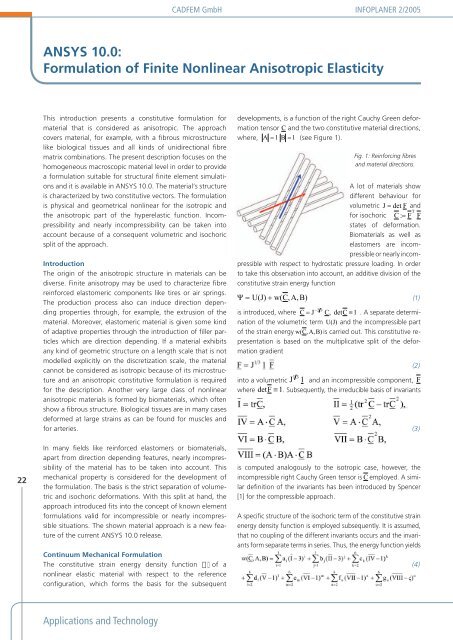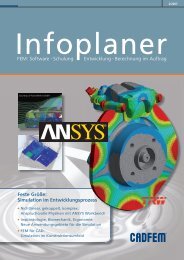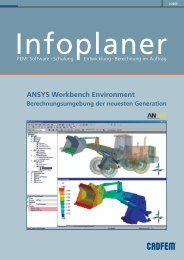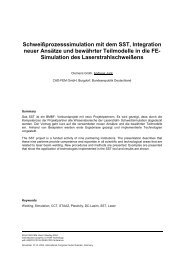FEM: Software • Schulung Entwicklung • Berechnung ... - CADFEM.CH
FEM: Software • Schulung Entwicklung • Berechnung ... - CADFEM.CH
FEM: Software • Schulung Entwicklung • Berechnung ... - CADFEM.CH
Sie wollen auch ein ePaper? Erhöhen Sie die Reichweite Ihrer Titel.
YUMPU macht aus Druck-PDFs automatisch weboptimierte ePaper, die Google liebt.
22<br />
ANSYS 10.0:<br />
Formulation of Finite Nonlinear Anisotropic Elasticity<br />
This introduction presents a constitutive formulation for<br />
material that is considered as aniso tropic. The approach<br />
covers material, for example, with a fi brous microstructure<br />
like bio logical tissues and all kinds of unidirectional fi bre<br />
matrix combinations. The present description focuses on the<br />
homo ge neous macroscopic material level in order to provide<br />
a formulation suitable for structural fi nite element simulations<br />
and it is available in ANSYS 10.0. The material’s structure<br />
is characterized by two constitutive vectors. The formulation<br />
is physical and geometrical nonlinear for the isotropic and<br />
the anisotropic part of the hyperelastic function. Incompressibility<br />
and nearly incompressibility can be taken into<br />
account because of a consequent volumetric and isochoric<br />
split of the approach.<br />
Introduction<br />
The origin of the anisotropic structure in materials can be<br />
diverse. Finite anisotropy may be used to characterize fi bre<br />
reinforced elastomeric components like tires or air springs.<br />
The production process also can induce direction depending<br />
properties through, for example, the extrusion of the<br />
material. Moreover, elastomeric material is given some kind<br />
of adaptive properties through the introduction of fi ller particles<br />
which are direction depending. If a material exhibits<br />
any kind of geometric structure on a length scale that is not<br />
modelled explicitly on the discretization scale, the material<br />
cannot be con sidered as isotropic because of its microstructure<br />
and an anisotropic constitutive formulation is required<br />
for the description. Another very large class of nonlinear<br />
anisotropic materials is formed by bio materials, which often<br />
show a fi brous structure. Biological tissues are in many cases<br />
deformed at large strains as can be found for muscles and<br />
for arteries.<br />
In many fi elds like reinforced elastomers or biomaterials,<br />
apart from direction depending features, nearly incompressibility<br />
of the material has to be taken into account. This<br />
mechanical property is considered for the development of<br />
the formulation. The basis is the strict separation of volumetric<br />
and isochoric deformations. With this split at hand, the<br />
approach introduced fi ts into the concept of known element<br />
formulations valid for incompressible or nearly incompressible<br />
situations. The shown material approach is a new feature<br />
of the current ANSYS 10.0 release.<br />
Continuum Mechanical Formulation<br />
The constitutive strain energy density function �� of a<br />
nonlinear elastic material with respect to the reference<br />
confi guration, which forms the basis for the subsequent<br />
Applications and Technology<br />
CAD<strong>FEM</strong> GmbH INFOPLANER 2/2005<br />
developments, is a function of the right Cauchy Green deformation<br />
tensor and the two constitutive material directions,<br />
where, (see Figure 1).<br />
,<br />
Fig. 1: Reinforcing fi bres<br />
and material directions.<br />
A lot of materials show<br />
different behaviour for<br />
volumetric J det F and<br />
T<br />
for isochoric C : F F<br />
states of deformation.<br />
Biomaterials as well as<br />
elastomers are incompressible<br />
or nearly incompressible<br />
with respect to hydrostatic pressure loading. In order<br />
to take this obser vation into account, an additive division of the<br />
constitutive strain energy function<br />
� � U(J) � w( C,<br />
A, B)<br />
2 3<br />
is introduced, where C � J C,<br />
detC<br />
� 1 . A separate determination<br />
of the volumetric term and the incompressible part<br />
of the strain energy is carried out. This constitutive repre<br />
sen tation is based on the multiplicative split of the deformation<br />
gradient<br />
�<br />
U(J)<br />
w( C,<br />
A, B)<br />
1 3<br />
into a volumetric and an incompressible component,<br />
where . Subsequently, the irre ducible basis of invariants<br />
is computed analogously to the isotropic case, however, the<br />
incompressible right Cauchy Green tensor is C<br />
employed. A similar<br />
defi nition of the invariants has been introduced by Spencer<br />
[1] for the compressible approach.<br />
A specifi c structure of the isochoric term of the constitutive strain<br />
energy density function is employed subsequently. It is assumed,<br />
that no coupling of the different invariants occurs and the invariants<br />
form separate terms in series. Thus, the energy function yields<br />
(1)<br />
(2)<br />
(3)<br />
(4)







